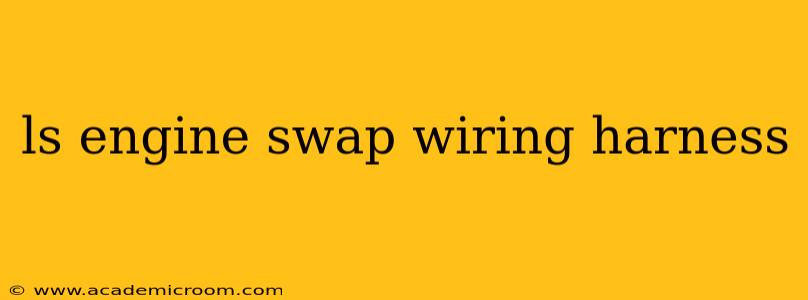Swapping an LS engine into a vehicle is a popular modification among car enthusiasts, offering a potent blend of power and relatively affordable components. However, the wiring harness presents a significant hurdle for many. This comprehensive guide will dissect the intricacies of LS engine swap wiring harnesses, addressing common questions and providing crucial insights for a successful installation.
What is an LS Engine Swap Wiring Harness?
An LS engine swap wiring harness is a specialized wiring system designed to integrate the LS engine's electronic control unit (ECU) with the recipient vehicle's electrical system. Unlike a factory harness, which is tailored to a specific vehicle, an LS swap harness adapts the engine's needs to the host car, allowing it to function correctly. This often involves custom connectors, relay circuits, and potentially modifications to the vehicle's existing wiring. Choosing the right harness, whether a pre-made unit or a custom solution, is paramount to a smooth and trouble-free installation.
What are the Different Types of LS Engine Swap Wiring Harnesses?
Several options exist when selecting an LS engine swap wiring harness, each with its own advantages and disadvantages:
-
Stand-alone Harnesses: These harnesses are complete, self-contained units designed to handle all the engine's electrical requirements. They typically offer plug-and-play functionality for various LS engines and simplify the installation process. However, they may be more expensive than other options.
-
Custom Harnesses: Fabricated from scratch, custom harnesses offer the ultimate flexibility, allowing for precise integration with the recipient vehicle. This approach enables tailored solutions for unique setups and challenging installations. However, it requires significant electrical knowledge and expertise.
-
Hybrid Harnesses: Combining elements of stand-alone and custom harnesses, these offer a balance of ease of use and customization. They may incorporate pre-made sections with areas designed for customized connections.
The best option hinges on your technical skills, budget, and the specific needs of your swap.
What are the Key Components of an LS Engine Swap Wiring Harness?
Understanding the components of an LS engine swap harness is critical for successful installation and troubleshooting. Key components include:
-
ECU Connector: This connects the engine's ECU to the harness, enabling communication and control.
-
Sensors and Actuators: The harness incorporates wiring for various sensors (e.g., crankshaft position sensor, throttle position sensor) and actuators (e.g., injectors, ignition coils). Proper connection of these components is crucial for engine function.
-
Power and Ground Wires: These deliver the necessary power and ground connections to the engine and its components.
-
Fuse and Relay Circuits: Protection circuits are built-in to safeguard the electrical system from overloads and shorts.
-
Vehicle Integration Components: These facilitate connection to the vehicle's existing systems, such as the gauges, lights, and accessories.
How Do I Choose the Right LS Engine Swap Wiring Harness?
Selecting the correct LS engine swap wiring harness requires careful consideration of several factors:
-
Year and Model of LS Engine: Different LS engines have varying wiring configurations. The harness must match the specific engine being installed.
-
Recipient Vehicle: The harness must be compatible with the vehicle's electrical system and chassis configuration.
-
Features and Options: Consider features such as integrated OBD-II support, provisions for auxiliary components, and the level of customization.
-
Budget: Harnesses range widely in price, depending on complexity and features.
Can I Install an LS Engine Swap Wiring Harness Myself?
Installing an LS engine swap wiring harness can be challenging, even for experienced mechanics. The complexity depends on the chosen harness type and the recipient vehicle. While some pre-made harnesses are designed for relatively straightforward installation, others may demand extensive electrical knowledge and troubleshooting skills.
Improper installation can lead to engine malfunctions, electrical issues, and even damage to the vehicle's systems. If you lack confidence in your electrical abilities, seeking professional help is strongly recommended.
What are the common problems encountered during LS engine swap wiring harness installation?
Common issues include incorrect wiring connections, damaged wires, insufficient power supply, and faulty ground connections. Thorough planning, meticulous attention to detail, and a methodical approach are essential to prevent these problems. Always double-check your wiring diagrams and connections before starting the engine.
Where can I find more information and support for LS Engine Swaps?
Numerous online forums, communities, and specialized websites are dedicated to LS engine swaps. These resources provide valuable information, troubleshooting assistance, and connections with experienced enthusiasts. These communities are an invaluable resource, offering support and advice during every stage of the swap.
This guide provides a starting point for understanding the complexities of LS engine swap wiring harnesses. Remember to always consult detailed wiring diagrams and prioritize safety during the installation process. With careful planning and the right resources, a successful LS engine swap is entirely achievable.
